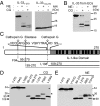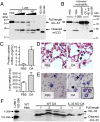IL-33 is processed into mature bioactive forms by neutrophil elastase and cathepsin G
- PMID: 22307629
- PMCID: PMC3277172
- DOI: 10.1073/pnas.1115884109
IL-33 is processed into mature bioactive forms by neutrophil elastase and cathepsin G
Abstract
Interleukin-33 (IL-33) (NF-HEV) is a chromatin-associated nuclear cytokine from the IL-1 family, which has been linked to important diseases, including asthma, rheumatoid arthritis, ulcerative colitis, and cardiovascular diseases. IL-33 signals through the ST2 receptor and drives cytokine production in type 2 innate lymphoid cells (ILCs) (natural helper cells, nuocytes), T-helper (Th)2 lymphocytes, mast cells, basophils, eosinophils, invariant natural killer T (iNKT), and natural killer (NK) cells. We and others recently reported that, unlike IL-1β and IL-18, full-length IL-33 is biologically active independently of caspase-1 cleavage and that processing by caspases results in IL-33 inactivation. We suggested that IL-33, which is released upon cellular damage, may function as an endogenous danger signal or alarmin, similar to IL-1α or high-mobility group box 1 protein (HMGB1). Here, we investigated the possibility that IL-33 activity may be regulated by proteases released during inflammation. Using a combination of in vitro and in vivo approaches, we demonstrate that neutrophil serine proteases cathepsin G and elastase can cleave full-length human IL-33(1-270) and generate mature forms IL-33(95-270), IL-33(99-270), and IL-33(109-270). These forms are produced by activated human neutrophils ex vivo, are biologically active in vivo, and have a ~10-fold higher activity than full-length IL-33 in cellular assays. Murine IL-33 is also cleaved by neutrophil cathepsin G and elastase, and both full-length and cleaved endogenous IL-33 could be detected in the bronchoalveolar lavage fluid in an in vivo model of acute lung injury associated with neutrophil infiltration. We propose that the inflammatory microenvironment may exacerbate disease-associated functions of IL-33 through the generation of highly active mature forms.
Conflict of interest statement
The authors declare no conflict of interest.
Figures






Similar articles
-
The IL-1-like cytokine IL-33 is inactivated after maturation by caspase-1.Proc Natl Acad Sci U S A. 2009 Jun 2;106(22):9021-6. doi: 10.1073/pnas.0812690106. Epub 2009 May 13. Proc Natl Acad Sci U S A. 2009. PMID: 19439663 Free PMC article.
-
Central domain of IL-33 is cleaved by mast cell proteases for potent activation of group-2 innate lymphoid cells.Proc Natl Acad Sci U S A. 2014 Oct 28;111(43):15502-7. doi: 10.1073/pnas.1410700111. Epub 2014 Oct 13. Proc Natl Acad Sci U S A. 2014. PMID: 25313073 Free PMC article.
-
Neutrophil extracellular traps can serve as platforms for processing and activation of IL-1 family cytokines.FEBS J. 2017 Jun;284(11):1712-1725. doi: 10.1111/febs.14075. Epub 2017 Apr 26. FEBS J. 2017. PMID: 28374518
-
The enigmatic processing and secretion of interleukin-33.Cell Mol Immunol. 2010 Jul;7(4):260-2. doi: 10.1038/cmi.2010.3. Epub 2010 Mar 22. Cell Mol Immunol. 2010. PMID: 20305685 Free PMC article. Review.
-
Interleukin-33 (IL-33): A nuclear cytokine from the IL-1 family.Immunol Rev. 2018 Jan;281(1):154-168. doi: 10.1111/imr.12619. Immunol Rev. 2018. PMID: 29247993 Review.
Cited by
-
Immunophenotyping and protein profiling of Fontan-associated plastic bronchitis airway casts.Ann Am Thorac Soc. 2013 Apr;10(2):98-107. doi: 10.1513/AnnalsATS.201209-080OC. Ann Am Thorac Soc. 2013. PMID: 23607837 Free PMC article. Clinical Trial.
-
Interleukin-33 in health and disease.Nat Rev Immunol. 2016 Nov;16(11):676-689. doi: 10.1038/nri.2016.95. Epub 2016 Sep 19. Nat Rev Immunol. 2016. PMID: 27640624 Review.
-
Interleukin-1 and Transforming Growth Factor Beta: Commonly Opposing, but Sometimes Supporting, Master Regulators of the Corneal Wound Healing Response to Injury.Invest Ophthalmol Vis Sci. 2021 Apr 1;62(4):8. doi: 10.1167/iovs.62.4.8. Invest Ophthalmol Vis Sci. 2021. PMID: 33825855 Free PMC article.
-
Targeting interleukin-33 and thymic stromal lymphopoietin pathways for novel pulmonary therapeutics in asthma and COPD.Eur Respir Rev. 2023 Jan 25;32(167):220144. doi: 10.1183/16000617.0144-2022. Print 2023 Mar 31. Eur Respir Rev. 2023. PMID: 36697211 Free PMC article. Review.
-
Short-term high fat feeding induces inflammatory responses of tuft cells and mucosal barrier cells in the murine stomach.Histol Histopathol. 2023 Mar;38(3):273-286. doi: 10.14670/HH-18-503. Epub 2022 Jul 29. Histol Histopathol. 2023. PMID: 35904321
References
-
- Dinarello CA. Immunological and inflammatory functions of the interleukin-1 family. Annu Rev Immunol. 2009;27:519–550. - PubMed
-
- Sims JE, Smith DE. The IL-1 family: regulators of immunity. Nat Rev Immunol. 2010;10:89–102. - PubMed
-
- Schmitz J, et al. IL-33, an interleukin-1-like cytokine that signals via the IL-1 receptor-related protein ST2 and induces T helper type 2-associated cytokines. Immunity. 2005;23:479–490. - PubMed
Publication types
MeSH terms
Substances
LinkOut - more resources
Full Text Sources
Other Literature Sources
Molecular Biology Databases
Miscellaneous

